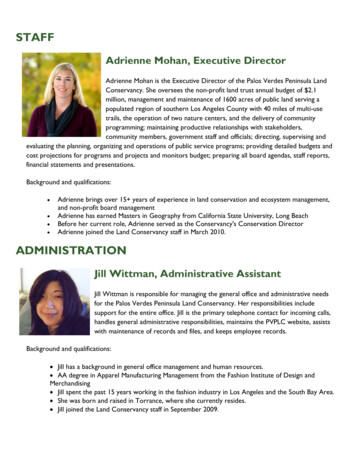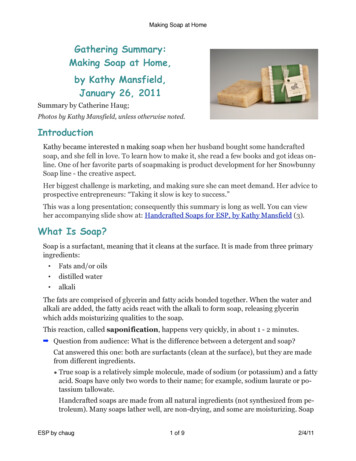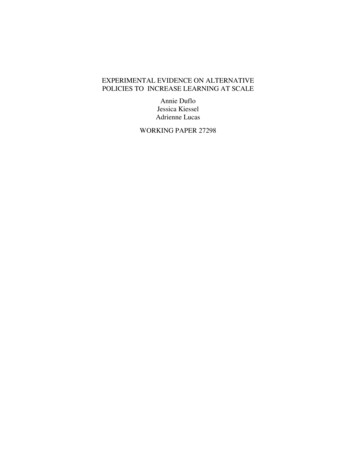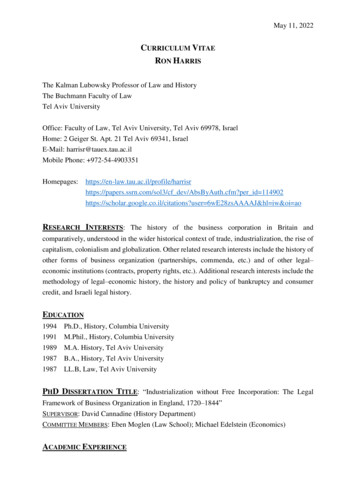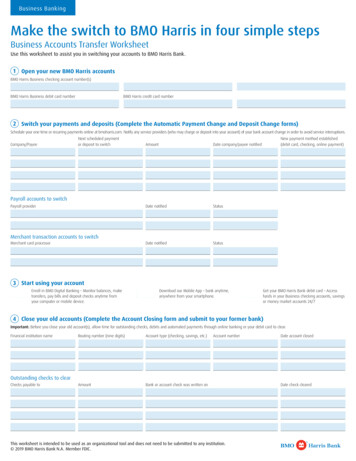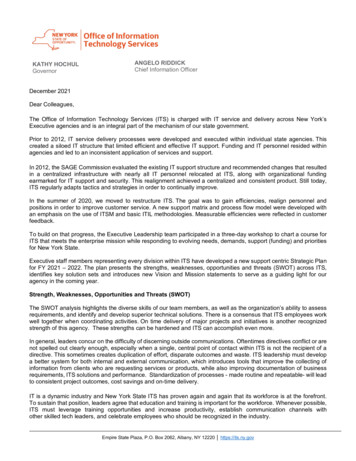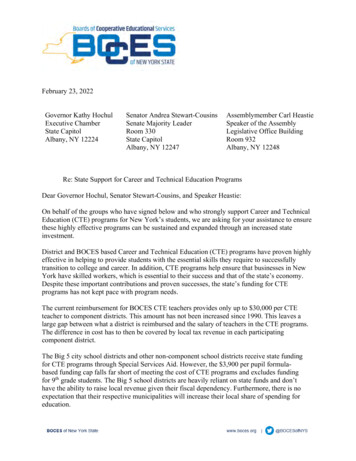
Transcription
KATHY HOCHULGovernorADRIENNE A. HARRISActing SuperintendentOctober 3, 2021Dear Speaker Heastie and President of the Senate Andrea Stewart-Cousins:Pursuant to the requirements of Part YY of Chapter 56 of the Laws of 2020, I hereby submit areport of the Administrative Simplification Workgroup.Respectfully submitted,Adrienne A. HarrisActing Superintendent of Financial Services
Report of New York’s Health CareAdministrative SimplificationWorkgroupOctober 3, 20212
Table of ContentsEXECUTIVE SUMMARY . 4Purpose of this Report . 4Summary of Recommendations . 5INTRODUCTION . 10THE HEALTH CARE ADMINISTRATIVE SIMPLIFICATION WORKGROUPDISCUSSIONS. 10Provider Credentialing . 10Preauthorization Practices . 15Access to Electronic Medical Records . 21Claim Submission, Payment, and Attachments . 25Insurance Eligibility and Overpayment Recovery . 27Facility Fees . 33Uniform Hospital Billing . 34Notification of Hospital Admissions, Discharges or Transfers . 35Claim Deadlines, Duplicate Claims, and Accounts Receivable . 36Health Care Claims Reports . 37Changes to Utilization Review – Failure to Respond to Initial Utilization Review Request. 38Changes to Utilization Review – Definition of a Clinical Peer Reviewer . 39CONCLUSION . 40HEALTH CARE ADMINISTRATIVE SIMPLIFICATION WORKGROUP MEMBERS . 413
EXECUTIVE SUMMARYPurpose of this ReportThe 2020 enacted Executive budget established a Health Care Administrative SimplificationWorkgroup tasked with studying and evaluating mechanisms to reduce health care administrative costsand complexities and protect consumers through standardization, simplification, or technology.1 Adiverse group of health care industry leaders representing consumer groups, hospitals, physicians,behavioral health providers, health insurers, brokers, and unions participated in meetings chaired bythe New York State Department of Financial Services (“DFS”), which also included the Department ofHealth (“DOH”), the Office of Mental Health (“OMH”), and the Office of Addiction Services andSupport (“OASAS”). Workgroup discussions focused on the topics specifically identified in the law provider credentialing, preauthorization practices, access to electronic medical records, claimsubmission and payment, claim attachments, and insurance eligibility verification—as well asadditional topics raised by Workgroup members. The Workgroup is required to submit by October 3,2021 a report and make recommendations to the Superintendent of Financial Services, theCommissioner of Health, the Speaker of the Assembly, and the Temporary President of the Senate.This report sets forth the findings and recommendations of the Workgroup.DFS thanks all Workgroup members for their significant time commitment and valuablecontributions. The Workgroup provided a unique opportunity for a diverse group of stakeholders tocome together to discuss important areas to improve the health care payment and delivery system forthe benefit of consumers, providers, and health plans. The Workgroup setting allowed the parties toreach consensus on many issues, and also identified issues where consensus could not be reached dueto a lack of trust between many providers and health plans. DFS will continue to work with allstakeholders to identify solutions to the issues where consensus was not reached.1Part YY of Chapter 56 of the Laws of 2020.4
Summary of RecommendationsBelow is a summary of the recommendations of the Workgroup. The Workgroup reachedconsensus on a number of the listed recommendations, and where consensus was not reached, thissummary notes where continued work is needed. This report further delineates the positions ofdifferent stakeholders where consensus was not reached.Credentialing1. Applicability of Credentialing Law. The Insurance Law should be amended to expand theapplicability of the credentialing timeframes and requirements to all comprehensive healthinsurance products with provider networks and to facilities.22. Applications & Follow-Up Questions. Health plans should use the standardized Council forAffordable Quality Healthcare (“CAQH”) credentialing application for credentialing health careprofessionals. Health plans should also develop a standard, simplified list of additional questionsas needed, as well as identify any follow-up information requests that can be standardized or usestandardized formats to obtain any follow-up information.3. Application Status Check. Health plans should implement an online portal or telephone hotlineto give providers real-time information and meaningful updates about their credentialingapplications, including the status of an application in the health plan’s review process and anyinformation that is missing from the application.4. Back & Forth Communications. Providers should ensure that their applications are complete,that their information in the CAQH database is up to date, and that they provide timely responses torequests for additional or missing information. Health plans should not request information thatwill be verified during Primary Source Verification, and health plans should review their PrimarySource Verification processes to ensure that duplicative information is not collected.2Insurance Law § 4803.5
5. Centralized Credentialing Database. Health plans and providers should collaborate to explorethe feasibility of an independent, centralized credentialing database, including thescope, functions, and overall parameters of the database.6. Facility Credentialing. The Workgroup should develop a standardized credentialing applicationfor health care facilities. Health plans should pre-populate re-credentialing applications forfacilities, and facilities should update any incorrect or incomplete information and providecomplete and timely responses. Health plans should work with facilities to re-credential all sites atthe same time, if requested by a facility.Preauthorization Practices1. Disclosure of Clinical Review Criteria. Health plans should post their clinical review criteria,including criteria used by delegated utilization review agents, in a centralized place on theirwebsites that is readily available to the public. If any information in the clinical review criteria isconsidered proprietary by a third party, health plans should create an online process to request theclinical review criteria.2. Timeframe to Provide Clinical Review Criteria Upon Request. Health plans (and theirdelegated utilization review agents) should provide clinical review criteria within five days ofreceiving a request for the information from an insured or their authorized representative. Ashorter timeframe should apply for expedited appeals.3. Standard Form for Designating an Authorized Representative. A standard form should bedeveloped for an insured to designate an authorized representative and that form should beaccepted by all health plans.4. Services that Require Preauthorization. Health plans should clearly identify the services that aresubject to preauthorization. At least annually, health plans should review services that aregenerally approved through preauthorization to identify where preauthorization requirements may6
be removed. Health plans should review circumstances where repeat preauthorizationrequirements for the same patient/same treatment can be eliminated. Health plans should adoptevidence-based and peer reviewed clinical guidelines with the most current data informing bestpractices for patient care and make the guidelines available to providers. Providers shouldsimilarly order services that are consistent with the plan’s evidence-based clinical guidelines,recognizing that there will be circumstances when the patient’s medical condition will necessitatevariation from such clinical guidelines.5. Peer-to-Peer Reviews. Peer-to-peer reviews for hospital services should involve physician tophysician communication, which may include the treating physician or a physician who isdesignated by, and either employed by or has privileges at, the hospital. The physicians discussingthe case for the health plan and hospital should be knowledgeable about the patient and treatment.6. Transmission of Documents. Health plans and providers are encouraged to adopt the HealthInsurance Portability and Accountability Act of 1996 (“HIPAA”) standard for electronictransmission of documents for preauthorization requests.Access to Electronic Medical Records Recommendations1. Requests for Medical Information. The Insurance Law and Public Health Law should beamended to apply to HMOs the limitation on medical record requests, which provides that onlyrecords necessary to verify medical necessity may be requested.32. Access to Electronic Medical Records. Health plans and providers should continue to discuss apath forward for providing access to electronic medical records, including the feasibility ofreaching individual or regional agreements to share such records, and options to streamline theexchange of medical records if access to electronic medical records is not provided.3Insurance Law § 4905(g) and Public Health Law § 4905(7).7
Claim Submission, Payment, and Attachments1. Claim Submission. Providers should submit claims electronically, where possible, instead of bypaper or facsimile, and health plans should accept claims that are submitted electronically.2. Claim Attachments. Providers should submit claim attachments electronically, through a webportal, where feasible. Health plans should offer assistance to providers to facilitate use of theirweb portals.3. Claim Attachment Standards. Health plans and providers should adopt the federal claimattachments standards as soon as a national standard is adopted by the Centers for Medicare &Medicaid Services (“CMS”).Insurance Eligibility Verification Recommendations1. Insurance Eligibility Verification. Health plans should make information regarding an insured’scoverage and benefits available to providers electronically. Employers should be included infurther discussions on measures to reduce the time period to notify health plans of changes to anemployee’s coverage and meaningful consequences for the failure of employers or benefitmanagers to provide accurate and timely information to health plans. DOH should considerpossible solutions to address Medicaid eligibility verification issues.2. Hospital Financial Assistance Forms. Hospitals that require completion of an application todetermine eligibility for financial assistance should be required to use a uniform standard financialassistance form. The income eligibility criteria should be standardized, as required by law, withflexibility permitted for hospitals to establish higher income eligibility standards to make assistanceavailable to more consumers. The form should be easily accessible, publicly available on eachhospital’s website and DOH’s website, and translated into languages other than English.3. Patient Financial Liability Forms. A standard patient financial liability form and standardizedfinancial liability language should be created, and the standard form or standardized language8
should be mandated when a liability form is used. The standardized form and language should notinclude unlimited financial liability language when impermissible.Topics Considered by the Workgroup in Addition to those Specifically Referenced in Law1. Facility Fees. Prior to rendering services, providers charging facility fees should disclose thatfacility fees will be charged by that provider and in what amount. Facility fees should not becharged when an office visit is for a preventive service for which cost-sharing is prohibited.2. Uniform Hospital Billing. DOH should continue discussions with stakeholders to explore ways tomake billing easier for consumers to understand.3. Notification of Hospital Admissions. Providers should notify health plans of hospital admissions,discharges, or transfers within 24 hours, or one business day if the admission, discharge, or transferoccurs on a weekend and health plan staff are unavailable, as a best practice in order to facilitatedischarge planning and care coordination.4. Claim Deadlines, Duplicate Claims, and Accounts Receivable. Health plans and hospitalsshould work collaboratively to develop standard terms, definitions, and methodologies to improvecommunication and reduce friction around claims activity.5. Health Care Claims Reports. The draft template health care claims report, which must becompleted by health plans and submitted to DFS starting in 2022, should be finalized in a timelymanner.9
INTRODUCTIONThe 2020 enacted Executive budget directed DFS, in conjunction with DOH, to convene aHealth Care Administrative Simplification Workgroup to study and evaluate mechanisms to reducehealth care administration costs and complexities through standardization, simplification, andtechnology. A diverse group of health care industry leaders representing consumers, hospitals,physicians, behavioral health providers, health insurers, insurance brokers, and unions served asWorkgroup members. The Workgroup was required to consider: provider credentialing;preauthorization practices; access to electronic medical records; claim submission and payment; claimattachments; and insurance eligibility verification. Additional topics were discussed, including facilityfees, notification of hospital admissions, claim deadlines, health care claims reports, and utilizationreview. The first meeting of the Workgroup was held on November 3, 2020, and the Workgroup metregularly over a ten-month period. This report describes the discussions and recommendations of theWorkgroup.THE HEALTH CARE ADMINISTRATIVE SIMPLIFICATION WORKGROUPDISCUSSIONSProvider CredentialingBackgroundCredentialing is the process used by health plans to assess and verify the qualifications of ahealth care provider (including Primary Source Verification of the provider’s state licensure, boardcertification, education and training, residency/fellowship programs, and malpractice history) todetermine whether the provider should be added to a plan’s network. The Insurance Law and PublicHealth Law set forth requirements and timeframes for the credentialing process, which begins when a10
health care professional completes a credentialing application and submits it to a health plan.4 Within60 days of receipt of a complete credentialing application, the law requires a health plan to review theapplication and notify the health care professional whether they are credentialed or whether additionaltime is needed because of a failure by a third party to provide necessary documentation. A health planmust make every effort to obtain the documentation and make a final determination within 21 days ofreceipt of the documentation. If a health plan does not approve or deny a completed application within60 days of receipt, a health care professional (either newly-licensed or recently relocated to New YorkState) in a group practice must be deemed “provisionally credentialed” and may participate in thehealth plan’s network. However, if the health care professional’s application is ultimately denied, thehealth care professional’s group practice must agree to refund any payments that were made for innetwork services provided by the provisionally credentialed health care professional and only collectthe in-network cost-sharing from the insured. In addition, a health plan must provisionally credential anewly-licensed physician, a physician who has recently relocated to New York State, or a physicianwho has changed their corporate relationship and becomes employed by a hospital or a facility uponreceipt of the hospital’s and physician's completed sections of a credentialing application, as well asnotification that the physician has been granted hospital privileges. Again, if the physician is notultimately credentialed, the health plan is not required to pay in-network benefits and the insured mustbe held harmless.Credentialing ProcessA significant issue raised by provider Workgroup members is that the credentialingtimeframes and requirements in the Insurance Law and Public Health Law only apply to healthmaintenance organizations (HMOs) and a very narrow category of health insurance policies (managed4Insurance Law § 4803 and Public Health Law § 4406-d. A health care professional is someone who is licensed,registered, or certified pursuant to Education Law Title 8.11
care products). In addition, the credentialing timeframes only apply to applications submitted byhealth care professionals and not to applications submitted by facilities.The Workgroup recommends that the Insurance Law be amended to apply the credentialingtimeframes and requirements to all comprehensive health insurance policies with provider networks.5In addition, the Workgroup recommends that the Insurance Law and Public Health Law be amended toextend the credentialing timeframes to include facility applications.Credentialing ApplicationWorkgroup members representing providers expressed concern regarding credentialingapplications and a lack of uniformity in related requests for information. These Workgroup membersnoted that health plans typically use a credentialing application provided by CAQH, which is anational, non-profit organization focused on streamlining the business of health care. However, healthplans frequently ask questions and request information from providers, in addition to those in theCAQH application form, including to address state Medicaid requirements or to obtain detailedmalpractice history, which may vary among the plans. Additionally, Workgroup membersrepresenting providers and facilities noted that some plans collect information with the initialapplication that would also be collected and verified during the Primary Source Verification process,which is unnecessary and burdensome. Workgroup members also noted that the CAQH application isdesigned for health care professionals and cannot be used for facility credentialing because it does notcollect all necessary information such as ownership, staffing, or site inspection history.The Workgroup recommends the continued use of the CAQH standard application for healthcare professional credentialing. Further, the Workgroup recommends that health plans develop astandard, simplified list of additional questions, as well as identify any follow-up information requeststhat can be standardized or use standardized formats to obtain any follow-up information.5Insurance Law § 4803.12
Status of Credentialing ApplicationsWorkgroup members representing providers stated that it is difficult to check on the status of acredentialing application after it is submitted to a health plan. Health plans stated that many planscurrently operate dedicated telephone hotlines or online portals for providers to request status reportsor have real-time communications. However, providers noted that some telephone hotlines or onlineportals do not provide meaningful information as to when credentialing will be completed. TheWorkgroup recommends that health plans implement an online portal or telephone hotline to provideeffective, real-time information and meaningful status updates for providers. Specifically, the onlineportal or telephone hotline should be able to identify missing information from the provider’scredentialing application and the status of the application in the health plan’s review process.Completion of Credentialing ApplicationsWorkgroup members noted that the back and forth required to obtain necessary informationduring the credentialing process is time consuming. Workgroup members representing health plansnoted that providers often submit incomplete applications, requiring the plan to reach out to theprovider to obtain the necessary information for a complete application. The Workgroup recommendsthat providers ensure that their applications are complete, review their information recorded in theCAQH database to make sure that it is up to date, and provide timely responses to requests foradditional or missing information. Additionally, Workgroup members representing providers notedthat health plans frequently request information that will be verified during the Primary SourceVerification process. The Workgroup recommends that health plans review their Primary SourceVerification processes to ensure that the health plan is not collecting duplicative information.Credentialing DatabaseWorkgroup members discussed the possibility of creating a centralized credentialing databaseto simplify the credentialing process. The database would contain the information needed to credentiala provider. Workgroup members recommend that plans and providers collaborate to explore the13
feasibility of an independent, centralized credentialing database, including the scope, functions, andoverall parameters of the database.Provisional CredentialingWorkgroup members discussed whether to expand provisional credentialing, which enables anewly-licensed or recently relocated physician joining a group practice or employed by a hospital to beconsidered an in-network provider before being fully credentialed by a health plan. It was noted byWorkgroup members representing health plans that provisional credentialing is not frequently used.Workgroup members representing providers pointed out that infrequent use of provisionalcredentialing may be due to the limited application of the Insurance Law provisions regardingcredentialing. Workgroup members noted that if improvements on other aspects of the credentialingprocess reduce credentialing timeframes, expansion of provisional credentialing may be unnecessary.Workgroup members representing consumers expressed concern that a provider might have a historyof malpractice or other misconduct that would not be revealed prior to provisional credentialing. TheWorkgroup did not reach a consensus on this issue.Facility CredentialingWorkgroup members representing facilities noted that credentialing applications for facilitiesare not uniform and that the CAQH application is not workable for facility credentialing. DFSsurveyed Workgroup members to obtain sample facility credentialing applications to determine thefeasibility of creating a standard application for facility credentialing. DFS created a draft standardfacility credentialing application and sent it to Workgroup members for feedback. The Workgrouprecommends continued collaboration on creating a standardized credentialing application that will beused for facilities.Workgroup members representing facilities also noted that during the re-credentialing process,facility credentialing applications are not pre-populated with information from a previous credentialingapplication. These Workgroup members found it time-consuming to re-enter this information during14
re-credentialing. Facilities also expressed concern that different facility sites are credentialed atdifferent times and suggested that health plans provide an option for all sites affiliated with the facilityto be credentialed at the same time. Workgroup members representing health plans noted that somehealth plans currently re-credential all affiliated sites at the same time. The Workgroup recommendsthat health plans pre-populate re-credentialing applications for facilities, with facilities updating anyincorrect or incomplete information, as opposed to facilities having to complete a new application eachtime the facility is re-credentialed, and that facilities provide complete and timely responses. TheWorkgroup also recommends that health plans work with facilities to re-credential all affiliated sites atthe same time if requested by a facility.Preauthorization PracticesBackgroundPreauthorization is a review that is conducted by a health plan or its utilization review agent todetermine whether a service is medically necessary before the service is provided to an insured.Preauthorization is permitted under Insurance Law and Public Health Law Articles 49, except foremergency services and certain mental health and substance use disorder treatments, and subject tocertain timeframes and requirements. When conducting preauthorization, health plans and theirutilization review agents typically use evidence-based and peer reviewed clinical review criteria, whichare a set of standards used to determine whether a health care service or treatment is medicallynecessary. The Insurance Law and Public Health Law require health plans to disclose the writtenclinical review criteria relating to a particular condition or disease upon written request of an insured,prospective insured, or the insured’s health care provider.6 Additionally, when a health plan orutilization review agent makes an adverse determination, it must state that the clinical review criteria6Insurance Law §§ 3217-a(b)(10) and 4324(b)(10) and Public Health Law § 4408(2)(j).15
relied upon to make the determination is available upon request of the insured or the insured’sdesignee.Disclosure and Timeframe to Provide Clinical Review CriteriaWorkgroup members representing consumers explained that access to clinical review criteriahelps insureds and providers understand what information should be provided for the service to beapproved and whether an appeal should be pursued, ideally leading to fewer denials and less need forappeals. Workgroup members representing consumers expressed concern that health plans and theirutilization review agents do not provide timely access to their clinical review criteria and would likethe clinical review criteria to be provided within one day for expedited cases. DFS remindedWorkgroup members that health plans are responsible for providing clinical criteria used by theirdelegated utilization review agents. Workgroup members representing health plans stated that it is acommon practice of health plans to post clinical review criteria on their websites. However,Workgroup members representing consumers noted that clinical review criteria are often only availablein “locked” areas of a plan’s website and therefore accessible only to an insured who has logged intothe plan’s website, making it difficult for authorized representatives and insureds who are not techsavvy to access the information.The Workgroup recommends that health plans post their clinical review criteria, includingcriteria used by delegated utilization review agents, in a centralized place on their websites that isreadily available to the public. If any information in the clinical review criteria is consideredproprietary by a third party, health plans should create an online process to request the clinical reviewcriteria. In addition, the Workgroup recommends that health plans and their delegated utilizationreview agents provide the requested clinical review criteria within five days of receiving such requestsfrom an insured or their authorized representative. If the request involves an expedited appeal, thehealth plan and their delegated utilization review agents should provide the clinical review criteriawithin a shorter time period.16
Additionally, Workgroup members representing consumers stated that some health plans takeweeks to process patient authorization forms. During this time, advocates and family members canonly speak to the health plan with the insured on the call. This is not feasible for many people who arereceiving inpatient treatment, where they do not have access to phones, or who are experiencing amental health or substance use crisis. Workgroup members representing consumers recommend thathealth plans be required to accept a standard form for insureds to designate an authorizedrepresentative and that health plans be held to specific timeframes to process an authorization for adesignated representative. Health plan Workgroup members expressed support for a standardauthorization form. The Workgroup recommends that a standard form be developed for an insured todesignate an authorized representative and that such form be accepted by all health plans.Services that Require PreauthorizationWorkgroup members representing providers expressed concern that each health plan has adifferent set of services that require preauthorization, so that providers with patients covered underdifferent health plans hav
Oct 3, 2021
